
The massacres of Poles in Volhynia and Eastern Galicia, were carried out in German-occupied Poland by the Ukrainian Insurgent Army, or the UPA, with the support of parts of the local Ukrainian population against the Polish minority in Volhynia, Eastern Galicia, parts of Polesia and Lublin region from 1943 to 1945. The peak of the massacres took place in July and August 1943. Most of the victims were women and children. Many of the Polish victims regardless of age or gender were tortured before being killed; some of the methods included rape, dismemberment or immolation, among others. The UPA's actions resulted in between 50,000 and 100,000 deaths.
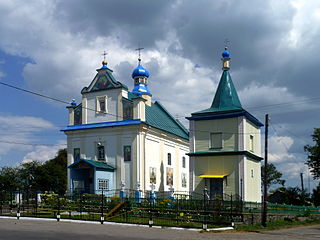
Pavlivka is a town now located in northwestern Ukraine, in Volodymyr Raion of Volyn Oblast, near Volodymyr, on the Luha river. For centuries, Poryck was property of several noble Polish families. The town is the birthplace of a Polish statesman Tadeusz Czacki. On 11 July 1943, the Ukrainian Insurgent Army, supported by local nationalists murdered here more than 300 Polish civilians, who had gathered in a local Roman Catholic church for a Sunday ceremony.

Dmytro Klyachkivsky, also known by his pseudonyms Klym Savur, Okhrim, and Bilash, was a commander of the Ukrainian Insurgent Army (UPA), first head-commander of the UPA-North. He was responsible for the ethnic cleansing of Poles from Volhynia.

Zygmunt Jan Rumel was a Polish poet and, during World War II, underground officer of the Bataliony Chłopskie partisans in the Wolhynia Region of the Second Polish Republic. Rumel's poetic talent was acknowledged by renowned Polish poet Leopold Staff and dramatist Jarosław Iwaszkiewicz. One of his poems entitled "Dwie matki" in which Rumel described his love of Poland and Ukraine, was published in a popular Płomyk magazine in 1935. He was killed by the Ukrainian Insurgent Army during the massacres of Poles in Volhynia in 1943.
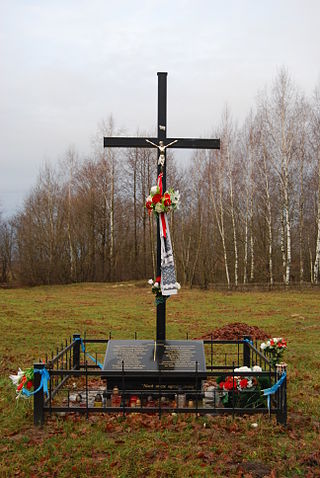
Huta Stepańska was an ethnic Polish village, located in prewar Kostopol county, Wołyń Voivodeship, in the Second Polish Republic. In 1943, during the Massacres of Poles in Volhynia, it became an important Polish self-defence centre, captured by the UPA between 16 and 18 July 1943. Some 2,000 UIA soldiers, supported by 3,000 local Ukrainian peasants, killed 300 Poles, as they were trying to break out of the encirclement.
Dominopol is a defunct village located in the present-day area of Volodymyr-Volynskyi Raion of Volyn Oblast in Ukraine. On July 11, 1943, at the height of the Massacres of Poles in Volhynia, the village was attacked by a death squad of Ukrainian Insurgent Army aided by the Ukrainian peasants, and all ethnic Poles regardless of age and gender were tortured and murdered. Before World War II, Dominopol was a village in the Eastern regions of the Second Polish Republic, located in the Gmina Werba, Powiat Włodzimierz of the Wołyń Voivodeship. The area was invaded by the Soviet Union in 1939 and during Operation Barbarossa annexed by Nazi Germany into Reichskommissariat Ukraine in 1941.
The village of Adamy was burned to the ground during the Massacres of Poles in Volhynia and Eastern Galicia, and no longer exists. It was destroyed by the Ukrainian Insurgent Army aided by the Ukrainian peasants who set ablaze 200 Polish farms and murdered whomever they could find. Adamy used to be located in powiat Kamionka Strumiłowa (county) near Busk in the Tarnopol Voivodeship of the Second Polish Republic before the Nazi-Soviet invasion of Poland in 1939.

Bortnytsia is a village in Rivne oblast, near the town of Dubno, in Dubno Raion, Ukraine. The village currently has a population of 365.
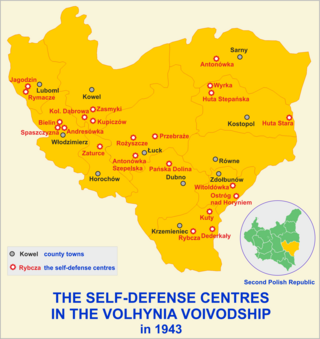
Stara Huta is a village in northwestern Ukraine, in Kovel Raion of Volyn Oblast, but was formerly administered within Stara Vyzhivka Raion. The population of the village is 1024 people.
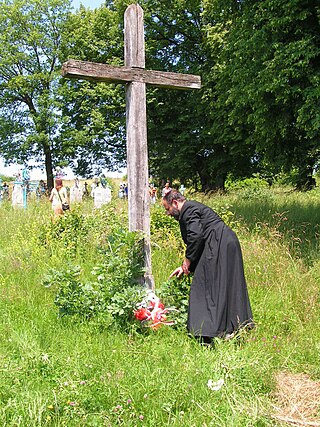
The Korosciatyn massacre took place on the night of February 28/29, 1944, during the province-wide wave of massacres of Poles in Volhynia in World War II. Korosciatyn, which now bears the name of Krynica and is located in western Ukraine, was one of the biggest ethnic Polish villages of the interwar Poland’s within Buczacz County in Tarnopol Voivodeship (pictured). Located along the railway line from Tarnopol to Stanislawów, in 1939 it had some 900 inhabitants, all of them being ethnic Poles. Korosciatyn had an elementary school, a Catholic church and a railway station. It belonged to the Catholic parish of nearby Monasterzyska, which also covered several nearby villages. Among the most famous of the citizens of this parish, are Rev. Stanislaw Padewski, professor Gabriel Turowski as well as two scientists, professor Michal Lesiow of Lublin’s Maria Curie University and doctor Jan Zaleski of Krakow’s Pedagogical College. Altogether, in 1939 the Deaconry of Buczacz had around 45 000 Polish inhabitants.
Massacre of Ostrówki refers to the mass murder of the Polish inhabitants of the Volhynian village of Ostrówki, located during the interbellum in the gmina Hushcha, Liuboml, Volhynian Voivodeship of the Second Polish Republic, now known as Ostrowky, located in the Manevychi Raion of Volyn, Ukraine. On 30 August 1943, armed members of the Ukrainian Insurgent Army (UIA) murdered 438 Poles. Among the victims were 246 children under the age of 14.

The Pidkamin massacre or the Podkamień massacre of 12 March 1944 was the massacre of Polish civilians committed by the Ukrainian Insurgent Army (UPA) under the command of Maksym Skorupsky (Maks), in cooperation with a unit of the 14th SS-Volunteer Division "Galician". The victims were ethnic Polish residents of the Eastern Galician village of Podkamień in the occupied Second Polish Republic's Tarnopol Voivodeship. During the war the area was administratively part of the Nazi German Reichskommissariat Ukraine. Estimates of victims include 150, more than 250 and up to 1000.
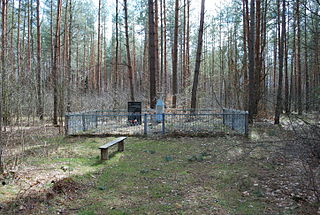
The Parośla I massacre was committed during World War II by the Ukrainian Insurgent Army (UPA) under the command of Hryhorij Perehijniak "Dowbeszka-Korobka" on 9 February 1943 against the ethnic Polish residents of the village of Parośla in the Nazi-controlled Reichskommissariat Ukraine. It is considered a prelude to the ethnic cleansing of Poles in the Volhynia region by the UPA, and is recognized as the first mass murder committed by the Ukrainian Insurgent Army in the area. Estimates of the number of victims range from 149 to 173.

Było sobie miasteczko... is a 2009 Polish historical documentary film about the 1943 Kisielin massacre in the village of Kisielin, located in the Wołyń Voivodeship in Poland before World War II,. The film, directed by Tadeusz Arciuch and Maciej Wojciechowski, was produced by Adam Kruk for Telewizja Polska.
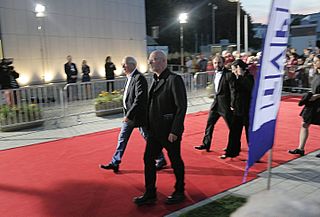
Volhynia or Hatred is a 2016 Polish war drama directed by Wojciech Smarzowski. The film is set in the 1939–1943 time frame and its central theme is Ukrainian anti-Polish hatred culminating in massacres of Poles in Volhynia. The screenplay was based on the collection of short stories titled Hate by Stanisław Srokowski.
Hurby massacre was a mass murder of the Polish population of the Hurby village, perpetrated on June 2, 1943, by a death squad of the Ukrainian Insurgent Army (UPA) and so-called brushwood self defence commando made up of Ukrainian peasants, during the province-wide Massacres of Poles in Volhynia and Eastern Galicia in World War II. Hurby belonged to the Second Polish Republic before the war began. It used to be located in the powiat Zdobłunowski of the Wołyń Voivodeship. It is now a valley by the same name in western Ukraine. About 250 Poles were murdered in the attack, which was confirmed by the UPA commander for Volyn, Dmytro Klyachkivsky, who said in his communique of June 1943 that Hurby "went up in smoke".
Gaj massacre was a wartime massacre of the Polish population of Gaj, committed on 30 August 1943 by the Ukrainian Insurgent Army death squad aided by the Ukrainian peasants, in which 600 civilian Poles were killed, including a large number of children. The mass murder operation in Gaj was carried out during the province-wide Massacres of Poles in Volhynia and Eastern Galicia. The settlement founded in the 1920s was burned to the ground by OUN-UPA and no longer exists. When the Polish self-defence unit from nearby Rożyszcze arrived at the Gaj colony a few days later the bodies of victims were strewn everywhere. They identified and shot several Ukrainian collaborators and set their houses of fire in retaliation. The Gaj colony was located in the Kowel County of the Wołyń Voivodeship in the Second Polish Republic.

Głęboczyca massacre was a mass murder of ethnic Poles carried out on 29 August 1943 by the troops of the Ukrainian Insurgent Army aided by the Ukrainian peasants. It exclusively targeted Polish inhabitants of the Głęboczyca colony, located in the Włodzimierz County of the Wołyń Voivodeship in the Second Polish Republic. About 250 Poles were killed, including 199 known by name including women and children. Głęboczyce does not exist anymore. It was swept from existence during the Massacres of Poles in Volhynia and Eastern Galicia, along with the neighbouring settlement of Ostrówek in powiat Luboml.

Budy Ossowskie massacre was a mass murder of ethnic Poles carried out on 29–30 August 1943 by a death squad of the Ukrainian Insurgent Army aided by the Ukrainian peasants during the Massacres of Poles in Volhynia and Eastern Galicia. About 290 people were killed, including women and children, all of them, Polish inhabitants of the Budy Ossowskie village, located in the Kowel County of the Wołyń Voivodeship in the Second Polish Republic. Budy Ossowskie village does not exist anymore. It was burned to the ground by the OUN-UPA. The charred remnants of the village were cleared in Soviet Ukraine for grazing cattle. Overall, in the Kowel County some 7,300 ethnic Poles were murdered.
Zagaje massacre was a mass murder of ethnic Poles carried out on 11–12 July 1943 by the troops of the Ukrainian Insurgent Army group "Piwnicz", aided by the Ukrainian peasants, during the Massacres of Poles in Volhynia and Eastern Galicia. Approximately 260–350 people were killed, including women and children. The village Zagaje was levelled out and does not exist anymore. It was located in the gmina Podberezie of the Horochów County in the Wołyń Voivodeship of the Second Polish Republic. Overall, in the Horochów County some 4,200 ethnic Poles were murdered, in nearly hundreds of separate locations before the end of the Polish-Ukrainian conflict. The village Zagaje is not to be confused with the Zagaje colony, located in gmina Czaruków, powiat Łuck, of the same voivodeship.
















